
Espresso
James RocheWhat Is Espresso?
Espresso isn’t a bean or a roast - it’s a brewing method. It’s short, intense, and the base of almost every drink on a café menu. Whether you’re into flat whites or just a proper double shot, understanding what espresso really is can help you brew better coffee at home (and avoid buying the wrong bag).

A well-spent puck tells you a lot — even surface, no channelling, and a good clean pull.
Espresso Defined
Espresso is coffee brewed under high pressure - usually around 9 bars - using finely ground coffee. The result is a small, concentrated shot with a thick body and a layer of crema on top. It’s made quickly, but that doesn’t mean it’s simple. A good espresso pulls complex flavour in 25–30 seconds: sweetness, acidity, bitterness, and depth - all balanced in 30–40ml.
Is Espresso a Type of Coffee Bean?
Nope. You’ll often see "espresso roast" on bags in the supermarket, but that’s more about how it’s roasted - usually darker, to suit the pressure and short extraction time. In reality, you can make espresso with almost any bean, as long as the grind, recipe, and machine are dialled in. We often prefer medium-light single origins, especially fruit-forward ones like Burundi Red Bourbon or African Moon - they give a clean shot with natural sweetness and acidity.

Crema isn’t just for looks - it’s the mark of freshness, pressure, and quality beans.
What Makes a Good Espresso?
- Grind size: Fine, but not powdery. You’re aiming for resistance, not choke.
- Pressure: 9 bars is standard, with a good pre-infusion if your machine allows it.
- Ratio: Most baristas use a 1:2 ratio - 18g in, 36g out in 25-30 seconds.
- Crema: A golden layer of foam on top that shows freshness and extraction.
☕ Brewing Tip
Use a scale and a timer - even a 2-second difference can throw off your espresso. 18g of coffee in, 36g out, 25–30 seconds is a solid starting point.
Can You Make Espresso Without a Machine?
Technically, no, real espresso needs pressure. But you can get close with gear like a Stovetop Moka Pot, Aeropress with pressure hacks, or even the Flair manual press. They won’t replicate full crema, but you’ll still get a rich, concentrated cup that’s more intense than filter coffee.

Dialling in at home - scales, grinders, and beans that actually do the work.
Espresso vs Coffee: What’s the Difference?
Espresso is just one way to brew coffee — it’s faster, smaller, and brewed under pressure. Traditional filter methods (like V60 or French press) use gravity and time instead. That means espresso is stronger in flavour and concentration, but not necessarily higher in caffeine per cup. It’s just more compact.
Best Beans for Espresso?
Dark roasts will give you that classic café taste - rich, chocolatey, and bold. But lighter roasts bring out fruit and acidity. We love using:
- Burundi Red Bourbon - great balance of brightness and body
- African Moon - natural processed, juicy and sweet
Experiment and see what works with your grinder and machine. Freshness is key - always aim for beans roasted in the last 4 weeks.

Espresso vs filter — same beans, different worlds.
Common Espresso Mistakes (and How to Fix Them)
Espresso’s unforgiving - small errors can ruin the shot. Here are a few common mistakes we see all the time (and how to sort them):
- Too fast? Your grind’s too coarse. If the shot gushes out in under 20 seconds, dial it finer.
- Too slow or choked? You’ve gone too fine or tamped too hard. Aim for a 25 to 30-second extraction time with steady pressure.
- Crema looks thin or disappears fast? Could be old beans. Always aim for beans roasted within the last 4 weeks.
- Channeling (spraying or uneven puck)? You’re tamping unevenly or grinding inconsistently. Use a WDT tool or prep more evenly before tamping.
- Shot taste sour? It’s under-extracted - try a finer grind or longer time.
- Tastes bitter or burnt? Over-extracted. Pull it faster or drop the dose slightly.
The key? Make one change at a time - and always time your shots. Espresso is 80% dialling in, 20% doing the same thing every time.
Want to Dial In Your Espresso Game?
We’re big on home brewing. Whether you’re just getting started or chasing that perfect shot, check out our other Brewing Guides or grab a bag of beans and start experimenting.


